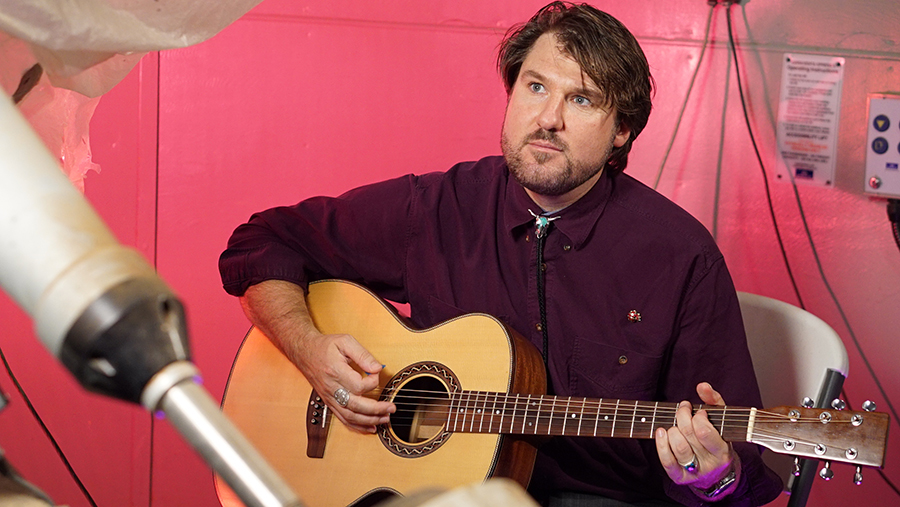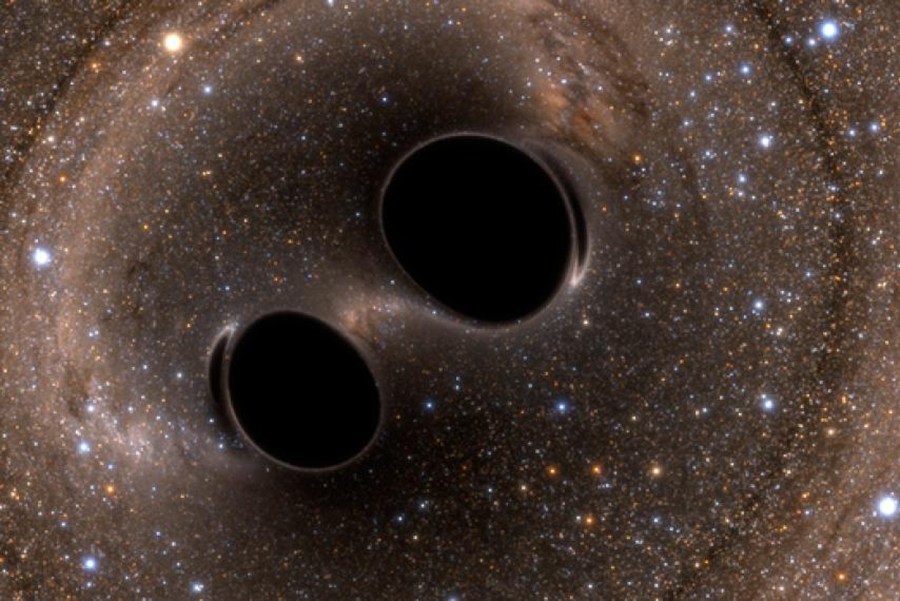The Sounds of Science
By: Sally Logue Post
Ra Inta has been fortunate to combine two of his passions, science and music, into one career. As a boy, Inta, who is a postdoctoral research fellow in Texas Tech University's Department of Physics and Astronomy, wanted to be a fire truck driver. He was four. But then his mother put him on a kid's rocket ship ride in front of a store in his native New Zealand and Inta's future was set, sort of.
"After that rocket ship ride I wanted to be an astronaut," he said. "I thought I had to study space science to do that. While the astronaut part wasn't to be, the interest in science stuck. Along the way I discovered Einstein and wound up studying physics."
So, how did a kid from New Zealand end up at Texas Tech University as part of an international team that made the first direct discovery of gravitational waves, proving Einstein's century-old theory of relativity? His path has taken a few odd turns, but the consistent element has always been waves.
Guitars and Physics
Music, especially guitars, caught Inta's interest during his teen years, but he continued his science studies, earning a bachelor's degree in physics from the University of Canterbury in New Zealand. But then the fates intervened.
“I was looking for doctoral programs and was sitting in an internet café and did a search for projects in Australia,” he said. “The first thing that popped up was a Ph.D. in acoustics and I thought ‘Wow, music, acoustics and guitar! What's going on here?' I pinched myself. I couldn't believe that I had found a program that combined my two passions.”
Inta won the position at the Music Acoustics Laboratory at the University of New South Wales in Australia and was able to combine his love of physics and the guitar.

Inta looked at how sound varies between guitars. As part of his study, he learned to build guitars. The major difference from a traditional guitar is that the three guitars he calls his physics guitars have an important addition -- a small, but powerful, magnet on the bridge that allows him to measure the vibrations of each guitar. The bridge is the piece that holds the strings at the bottom of the guitar.
“I tried to make guitars that are as similar as possible to each other,” he said. “It was something of a physics nightmare, because two pieces of wood from the same tree can have different properties.”
His sponsor for his doctoral project, “The Acoustics of the Steel String Guitar,” was a major stocker for guitar wood in Australia. The company allowed him to go through all their wood to pick the ones most similar to each other.
Inta measured the vibrations of different parts of the guitar and during different stages of construction. He was trying to determine if different construction techniques could influence the sound of the guitar. He also investigated the long-standing legend that violins sound better after they've been aged and/or played regularly.
The bottom line: while there is agreement between players and listeners of what constitutes a bad instrument, there is disagreement about what 'good' means.
“There is a lot of disagreement and it often depends on the taste of the listener or player,” he said. “Do you like a more classical sound, or something that is more rock? You could draw an analogy to wine tasting; it depends on the individual.”
However, like many wines, there was no evidence players or listeners could tell an aged or played violin from its control twin.
Inta points to the lack of easily measurable quantities associated with the words to describe sound quality, or 'timbre,' as an issue. While there are words to define tastes — sweet, sour, bitter, salty — there are no specific words to measure sound quality.
“We can easily measure volume and pitch, but this is not the case for the various elements of sound,” he said.
Talking to Termites
After his doctoral work on guitars, Inta had become something of an expert at looking at vibrations in wood. That expertise landed him a job with the Australian Defence Force Academy listening to termites.
Inta's team brought termite mounds into the laboratory to study, a time consuming and very hot job.
“The laboratory was deep underground in these cavernous tombs that were really hot and moist,” he said. “Good for termites, but even when it was freezing outside, we were wearing shorts and t-shirts to be comfortable.”
His job? To pick out the signals the termites were sending to each other.
“Termites produce their own vibrations as they move through wood,” he said. “What I brought to the party was the ability to extract those vibrations, or signals, from the wood and determine what was being communicated and perhaps talk back to the insects and communicate that they should leave the wood they were invading.”
This work resulted in a patent for putting termites off eating wood by using their own vibratory communication signals.
The Sounds of Space-time: Gravitational Waves
It wasn't long before Inta found himself part of an international team looking at similar types of signals, but from a very different source: those sent out by ripples in space-time, known as 'gravitational waves'.
Inta had taken a postdoctoral position at Penn State University working in the laboratory of Professor Benjamin Owen. After about a year, Owen made a move to Texas Tech, bringing Inta with him. Their focus was looking at the results of searches for gravitational waves as part of the 1,000 member National Science Foundation-funded Laser Interferometer Gravitational-wave Observatory (LIGO). The three scientists who played a key role in the LIGO project, Kip Thorne and Barry Barish of the California Institute of Technology and Rainer Weiss of the Massachusetts Institute of Technology, won the 2017 Nobel Prize in Physics for their LIGO contributions.
Einstein published his general theory of Relativity in 1915, one of the most monumental advances in modern physics. He theorized that what we know as gravity comes from the curvature of space and time and is used to explain the history of the Universe and black holes. We couldn't have GPS without it. The following year, he used this theory to predict gravity could move in tiny waves.
Inta says that even Einstein wasn't sure if this part of his theory could be tested simply because of how sensitive the instrumentation would need to be. But in September 2015 the first observation of gravitational waves was recorded when two massive black holes collided, forming a single, monster black hole. The observation came from the extremely sensitive equipment of the LIGO group.
Inta is one of seven Texas Tech researchers who are part of the LIGO collaboration. His job is to look through the data from the LIGO observatories and look for tiny signals buried deep in the noise.
“It's said that in space, no one can hear you scream. That is, unless you're a massive star or a black hole. Then you vibrate the very fabric of space and time itself,” he said. “The LIGO instrumentation was able to turn the energy signals radiating from the black holes into something very similar to a sound signal. We are fortunate to have 'heard' those vibrations.”
Exploring the Future

(Credit: SXS)
Gravitational wave events have now been observed six times by the LIGO group, and Virgo, a separate observatory. The discovery opens up a new window to allow scientists to explore space. Along the way, this has helped us understand a number of things, such as where heavy elements, like platinum and gold, come from.
“People should care about fundamental research, such as this,” he said. “Are you attached to your mobile phone? Well most technology that went into it came from curiosity-driven research.”
He also warns that new developments may not come quickly. He says, in the 1890s, some in the physics community predicted there would be no new discoveries. But then x-rays were discovered in 1895, touching off a revolution in medicine, quantum mechanics and radioactivity.
“You would lose so much by limiting fundamental research,” he said. “The level of instrumentation that went into the LIGO project is mind-blowing. This can result in near-term advances and spin off technologies, but we have no idea of the future ramifications of these discoveries.”
Discoveries
-
Address
Texas Tech University, 2500 Broadway, Box 41075 Lubbock, TX 79409 -
Phone
806.742.3905 -
Email
vpr.communications@ttu.edu
